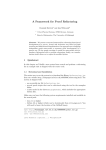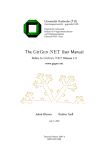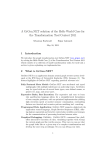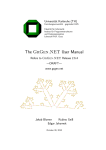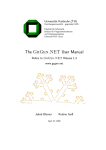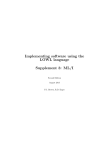Download Optimizing a Solution for the TTC 2014 Movie Database Case
Transcript
Optimizing a Solution for the TTC 2014 Movie Database Case
Edgar Jakumeit
The task of the Movie Database Case [2] is to identify all couples of actors who performed together
in at least three movies. The challenge of the task is to do this fast on a large database. We employ the
general purpose graph rewrite system G R G EN .NET in developing, and esp. optimizing a solution.
You are interested in this paper if you want to learn how to optimize G R G EN .NET for performance.
1
What is GrGen.NET?
G R G EN .NET (www.grgen.net) is a programming language and development tool for graph structured
data with pattern matching and rewriting at its core, which furthermore supports imperative and objectoriented programming, and features some traits of database query-result processing.
Founded on an rich data modeling language with multiple inheritance on node and edge types, it
offers pattern-based rewrite rules of very high expressiveness, with subpatterns and nested alternative,
iterated, negative, and independent patterns, as well as preset input parameters and output def variables
yielded to. The rules are orchestrated with a concise control language, which offers constructs that are
simplifying backtracking searches and state space enumeration.
Development is supported by graphical and stepwise debugging, as well as search plan explanation
and profiling instrumentation for graph search steps – the former helps in first getting the programs
correct, the latter in getting them fast thereafter. The tool was built for performance and scalability: its
model data structures are designed for fast processing of typed graphs at modest memory consumption,
while its optimizing compiler adapts the search process to the characteristics of the host graph at hand
and removes overhead where it is not needed.
G R G EN .NET lifts the abstraction level of graph-representation based tasks to declarative and elegant
pattern-based rules, that allow to program with structural recursion and structure directed transformation
[3]. Employing G R G EN .NET one is able to achieve the highest combined speed of development and
execution available for graph-based tasks.
2
Data transformation
The input supplied for the case is in XMI format, following the EMF modeling. This means esp. that in
between Movie and Person nodes we find movies and persons references resp. edges, always a pair
of them, one in the opposite direction of the other. These twins offer no addition information, they just
allow to find the opposite node either way. This would be wasteful for G R G EN whose edges are always
navigable in both directions.
So as a preparatory step we apply a model-to-text transformation, mapping the XMI models supplied
to GRS files, the native serialization format of G R G EN .NET. The central rule create personToMovie
in GrgenifyMovieDatabase.grg emits a new edge command for a personToMovie edge upon visiting a pair of movies and persons. The transformation is applied on all input files with a shell script
GrgenifyMovieDatabase.sh containing a call to the G R S HELL with a here-document specifying the
workflow. In the following steps we then import the GRS files with the single edges.
To appear in EPTCS.
c Edgar Jakumeit
2
Optimizing a Solution for the TTC 2014 Movie Database Case
A further benefit from this model mapping are the cleaner names of the manually specified model,
compared to the model that is auto-generated when the ecore/XMI is imported. The latter mechanism
applies name mangling – which is needed to prevent name clashes of global edge types stemming from
multiple equally named references that are contained in the type of their node, and for preventing collisions with G R G EN .NET keywords.
Removing the edges reduces memory consumption and improves cache utilization, the gains are
considerable when working with millions of objects 1 , since G R G EN always implements directed, typed,
multi-graphs with/for each of its entities, storing them in a system of ringlists, which allows for fast
pattern matching and rewriting, with lookups by type in constant time, accesses of incident elements in
constant time, and graph additions and removals in constant time.
3
Getting it right
As always, the first step is to get a correct solution specified in the cleanest way possible, and only later
on to optimize it for performance as needed.
Main rule (Tasks 2 and 3)
The workhorse rule for finding all pairs of persons which played together in at least three movies is
findCouples.
rule findCouples
{
pn1 : Person ; pn2 : Person ;
independent {
pn1 -: personToMovie - > m1 : Movie < -: personToMovie - pn2 ;
pn1 -: personToMovie - > m2 : Movie < -: personToMovie - pn2 ;
pn1 -: personToMovie - > m3 : Movie < -: personToMovie - pn2 ;
}
modify {
c : Couple ;
c -: p1 - > pn1 ;
c -: p2 - > pn2 ;
exec ( a d d C o m m o n M o v i e s A n d C o m p u t e A v e r a g e R a n k i n g (c , pn1 , pn2 ));
}
} \ auto
Figure 1: findCouples rule
It specifies a pattern of two nodes pn1 and pn2 of type Person, and an independent pattern which
asks for 3 nodes m1, m2, m3 of type Movie, each being the target of an edge of type personToMovie
starting at pn1, and each being also the target of an edge starting at pn2. (Types are given after a colon,
1 The
memory consumption of a G R G EN .NET edge without attributes is 52 bytes using a 32bit CLR (9 pointers a 4 bytes,
a 4 bytes flags field/bitvector, a 4 bytes unique id field, plus 8 bytes .NET object overhead), it is 96 bytes for a 64bit CLR (9
pointers a 8 bytes, a 4 bytes flags field, a 4 bytes unique id field, plus 16 bytes .NET object overhead). A node without attributes
uses up 36 bytes, or 64 bytes on 64bit. Attributes only add the .NET overhead of their implementation type.
Edgar Jakumeit
3
rule a d d C o m m o n M o v i e s A n d C o m p u t e A v e r a g e R a n k i n g ( c : Couple , pn1 : Person , pn2 : Person )
{
iterated it {
pn1 -: personToMovie - > m : Movie < -: personToMovie - pn2 ;
modify {
c -: commonMovies - > m ;
eval { yield sum = sum + m . rating ; }
}
}
modify {
def var sum : double = 0.0;
eval { c . avgRating = sum / count ( it ); }
}
}
Figure 2: addCommonMoviesAndComputeAverageRanking rule
the optional name of the entity may be given before the colon, for edges they are inscribed into the edge
notation -->).
An independent pattern means for one that its content only needs to be searched and is not available
for rewriting, and for the other that for each pn1 and pn2 in the graph, it is sufficient to find a single
instance of the independent, even if the rule is requested to be executed on all available matches –
without the independent we would get all the permutations of m1, m2, and m3 as different matches.
The rewriting is specified as nested pattern in modify mode, which means that newly declared entities will be created, and all entities from the matched pattern kept unless they are explicitly requested to
be deleted. Here we create a new node c of type Couple, link it with edges of the types p1 and p2 to the
nodes pn1 and pn2, and then execute the helper rule addCommonMoviesAndComputeAverageRanking
on c, pn1, and pn2. The helper rule is used to create the commonMovies edges to all the movies both
played in.
The auto keyword after the rule requests G R G EN .NET to generate a symmetry filter for matches
from automorphic patterns. The pattern is automorphic (isomorphic to itself) because it may be matched
with pn2 for pn1 and pn1 for pn2.
To get all pairs of persons which played together in at least three movies we execute the rule with allbracketing from a graph rewrite sequence in the G R S HELL script MovieDatabase.grs, filtering away
automorphic matches, with the syntax: exec [findCouples\auto].
The helper rule addCommonMoviesAndComputeAverageRanking shown in Figure 2 eats all common movies with an iterated pattern which is matched as often as possible; in the rewrite part it links
the Couple node to each such movie with a commonMovies edge. In the eval part used for attribute
evaluation, the avgRating is computed as the sum of the ratings of the movies munched, divided by the
count of the iterateds matched. The def var is used to define a variable whose content is computed
after matching from the matched entities, the yield is used to assign to such variables, from nested
patterns up to their containing patterns (normally variables are passed the other way round, from nesting
to nested patterns, following the flow of matching).
The language constructs are explained in more detail in the extensive G R G EN .NET user manual [1].
4
Optimizing a Solution for the TTC 2014 Movie Database Case
Figure 3: The smallest synthetic model in the graph viewer
Test data and Top Couples (Task 1 and Extension Task 1)
The synthetic test set of task 1 is generated with the rules in MovieDatabaseCreation.grg, with the iteration for{i:int in [0:n-1]; createPositive(i) ;> createNegative(i)} in the sequence
definition createExample, applying the rules createPositive and createNegative in succession.
You can check they are correctly generated with the graph viewer supplied with G R G EN .NET. In
Figure 3 you see the smallest generated synthetic model, with actors colored yellow and movies colored
blue.
The extension task 1 requires to compute the top couples according to the average rating of their common movies, and according to the number of common movies. It is solved with the rule couplesWithRating that you find in Figure 4. We use the rule twice, ordering the matches differently. The sequence
[couplesWithRating\orderDescendingBy<avgRating>\keepFirst(15)] executed from the G R S HELL asks for all matches of the rule couplesWithRating, then sorts them descendingly by the avgRating pattern variable, then throws away all but the first top 15 matches. The other value of interest
is handled in exactly the same way.
The rule couplesWithRating in Figure 4 matches a Couple and its linked Persons. Two def
variables avgRating and numMovies for the values of interest are created and filled with the average
rating stored in the couple nodes, and the number of movies as computed from the size of the set of
commonMovies edges outgoing from the couple node. We employ a yield block to assign the variables
(bottom-up) after the (top-down) pattern matching completed. In the rewrite part specified in modify
mode we just emit the values of interest. Furthermore, we request G R G EN to generate sorting code for
the def pattern entities avgRating and numMovies with the declaration of the auto-generated matches
accumulation filters orderDescendingBy<avgRating> and orderDescendingBy<numMovies>.
You can inspect the found results with the debugger of G R G EN .NET. It highlights the matched
Edgar Jakumeit
5
rule couplesWithRating
{
c : Couple ;
c -: p1 - > pn1 : Person ;
c -: p2 - > pn2 : Person ;
def var
def var
yield {
yield
yield
}
avgRating : double ;
numMovies : int ;
avgRating = c . avgRating ;
numMovies = outgoing (c , commonMovies ). size ();
modify {
emit ( " avgRating : " + avgRating + " numMovies : " + numMovies
+ " by " + pn1 . name + " and " + pn2 . name + " \ n " );
}
} \ orderDescendingBy < avgRating > , orderDescendingBy < numMovies >
Figure 4: couplesWithRating rule
Figure 5: Debugging the top match from the 10000 movies file
6
Optimizing a Solution for the TTC 2014 Movie Database Case
pattern of the (currently executed) rule in the current graph, and displays the effects of the rewriting
step before it leads to the follow-up graph. This only works with the full graph for the smaller autogenerated and the smallest IMDB-derived graph, though. The larger graphs are too costly to visualize
(which simply poses a general problem of large graphs irrespective of the chosen viewer – besides you
would get lost in a haystack). But we can configure the debugger with dump add graph exclude to
show only the matched entities, plus the one-step connected elements as context. This way we can still
inspect what G R G EN found. In Figure 5 can you see a visualization of the match with most connections,
in layout Circular (take a look at MovieDatabaseLayout.grs to find out about the visualization
configuration applied to reach this).
We achieved Figure 5 by executing the sequence
$%[couplesWithRating\orderDescendingBy<numMovies>\removeFirst(0)\keepFirst(1)]
in debug mode. First all matches are sought, then they are ordered descendingly alongside the number
of common movies, then the first 0 matches (i.e. nothing) are removed – increase this value to k to
inspect the kth match from the matches found. Afterwards,all but the first 1 remaining match is removed
– increase this value to k to inspect the first k remaining matches at once. The $ chooses one match from
all matches found that remain after sorting and filtering, the % allows you to cycle through the matches
in the debugger.
Cliques (Extension Tasks 2 and 3 and 4)
The other extension tasks asking to find cliques of actors are solved with manually coded rules for the
sizes 3, 4, and 5 as a straightforward generalization of the couples-based task; higher-order or metaprogramming is not supported (and won’t be, you have to employ an external code generator if needed).
4
Getting it fast
The most important point to understand when optimizing for speed is that the expensive task is the search
carried out during pattern matching.
Searching is carried out with a backtracking algorithm following a search plan in a fixed order,
binding one pattern element after another to a graph element, checking if it fits to the already bound
parts. If it does fit search continues trying to bind the next pattern element (or succeeds building the
match object from all the elements bound if the last check succeeds), if it does not fit search continues
with the next graph element; if all graph element candidates for this pattern element are exhausted, search
backtracks to the previous decision point and continues there with the next element.
Typically, the first pattern element is determined with a lookup operation reaching into the graph,
binding the pattern element to a graph element of the required type (the less elements of that type exists,
the better); then neighbouring elements are traversed following the graph structure (the less neighbouring
elements exists, the better), until a match of the entire pattern is found.
Initial and Host-Graph-Adapted Search Plans
For each pattern, G R G EN .NET creates a static un-optimized search plan (automatically, behind the
scenes). You can inspect it for each rule with the custom actions explain command. For findCouples it delivers the output displayed in Figure 6.
The search plan in Figure 6 shows us that the graph is entered with a lookup of a personToMovie
edge, then the candidates for the source node pn1 and the target node m1 are extracted from it. Afterwards
Edgar Jakumeit
7
static search plans
findCouples:
lookup -_edge0_inlined_idpt_0:personToMovie-> in graph
from <-_edge0_inlined_idpt_0- get source pn1:Person
from -_edge0_inlined_idpt_0-> get target m1_inlined_idpt_0:Movie
from m1_inlined_idpt_0 incoming <-_edge1_inlined_idpt_0:personToMoviefrom <-_edge1_inlined_idpt_0- get source pn2:Person
independent {
(preset: pn1)
(preset: m1 after independent inlining)
(preset: pn2)
(preset: _edge0 after independent inlining)
(preset: _edge1 after independent inlining)
from pn1 outgoing -_edge2:personToMovie->
from -_edge2-> get target m2:Movie
from pn1 outgoing -_edge4:personToMovie->
from -_edge4-> get target m3:Movie
from pn2 outgoing -_edge3:personToMovie->
from pn2 outgoing -_edge5:personToMovie->
}
Figure 6: Initial search plan
the other personToMovie edge is matched in reverse from the movie to pn2. Several elements in the
independent are handed in as already matched presets from the outer pattern, then the personToMovie
edges are taken from pn1 to the movies m2 and m3, and finally the personToMovie edges from pn2 are
matched, with an implicit check that the target movie is the same as the one already matched.
We see here an automatically applied optimization, the movie m1 was inlined from the independent
pattern to its containing pattern. Without this optimization, pn1 and pn2 would have to be enumerated
in the main pattern unconnected, resulting in the unfolding of the cartesian product of all Person nodes,
before handing it in to the matcher of the nested independent pattern to purge the actors without a connecting movie. This is a crucial optimization that saves us from the execution time explosion of the
O(n ∗ n) cartesian product.
We can do better with search plans adapted to the host graph, towards this end we issue a custom
graph analyze followed by a custom actions gen searchplan command. The first computes
some information about the multiplicities of the types and esp. the multiplicities of the connections
in between the types from the host graph, the latter re-generates the matchers at runtime based on those
graph characteristics gathered, replacing the auto-generated ones. For the small IMDB graphs, this
results in a lookup of m1, extending on the one side to pn1, and on the other to pn2. For the large
IMDB graph this results in a lookup of pn1, extending to m1, then extending to pn2. This leads to a
small runtime improvement, esp. together with a later attribute condition (for many tasks, the gains are
higher).
8
Optimizing a Solution for the TTC 2014 Movie Database Case
Profiling, Big-O, and Pruning
Things are getting really slow with increasing graph size and esp. connectedness of the IMDB graphs.
We must go into greater details – let’s start profiling. We do so with the new set profile on command
at the begin of the shell file before the graph is created, and a show profile findCouples command
thereafter. Profiling shows us a massive increase in the number of search steps with the graph sizes,
hinting at an O(n ∗ n) algorithm: the 207,876 nodes graph requires 1,259,006,408 search steps, executed
in a bit below 9 seconds; the 405,592 nodes graph requires 9,541,314,556 search steps, executed in a bit
below 46 seconds.
Inspecting the top connected matches visually and aligning them with the search plan we understand
why: the pattern matcher has to follow all edges from pn1 on and all edges from pn2 on, to find and
bind the common movies, giving us an O(n ∗ n) iteration (with n being the number of adjacent movies).
The iteration is not much of an issue for actors with few connections (i.e. sparse graphs), but gets very
expensive for massively connected actors. Here we simply have to revert to a non-pattern based approach
to compute the set of common nodes. You see it displayed in Figure 11 in section 6 with an intersection
of two sets (delivered by the built-in adjacentOutgoing function), which is O(n) because the hash set
lookup employed by the intersection operator & is O(1).
We apply a further optimization that prunes the search space earlier. Instead of finding and materializing the automorphic matches, just to remove them later on with an automorphic matches filter,
we reject them straight ahead. To this end, we require that the unique id of the actor bound to pn1 is
smaller than the unique id of the actor bound to pn2. Unique ids are unique integer numbers assigned by
G R G EN .NET after they have been requested with a node edge unique declaration in the model (they
render deletion a bit more expensive, which is why they are not active by default).
Furthermore, we optimize addCommonMoviesAndComputeAverageRanking. Instead of iterating
all common movies from within one rule application, computing the averages from the iterated patterns,
do we only add the common movies in this step without averaging (more is not requested), with an allbracketed application of addCommonMovies (cf. Figure 12 in section 6) which saves us the overhead of
the graph parser employed in matching iterated, alternative, and subpatterns. Whose costs are not huge,
but they can be felt.
After the optimization, the 207,876 nodes graph requires 42,195,046 search steps, executed in a
bit above 10 seconds. The 405,592 nodes graph requires 110,809,701 search steps, executed in a bit
above 22 seconds. We get a considerable decrease in search steps, and esp. a considerably slowed down
increase with increasing graph size and connectedness. The larger graph is processed twice as fast, but
the smaller one is in fact processed a bit slower – hash set based connectedness checking only pays off
for high connectedness degrees.
Further Pruning and Strength Reduction
The set intersection already helped regarding the big-O, we still can do better: only 3 common movies
are needed, so we replace it with a dedicated algorithm that iterates one set and checks whether the
movies are available in the other, leaving early after 3 such movies were found. In excess, this algorithm
only needs to allocate and fill one single set. You can find this helper function atLeastThreeCommonMoviesIntermediateOpt2 in Figure 14 in section 6.
It takes two Persons pn1 and pn2 as arguments and returns true if they are linked by at least three
common movies, and returns false otherwise. For each movie, it checks with a hash set lookup in O(1)
whether it is common to the persons. We even use an adaptive helper function here; we first find out
Edgar Jakumeit
9
rule findCouplesOpt [ parallelize =16]
{
pn1 : Person ; pn2 : Person ;
hom ( pn1 , pn2 );
independent {
pn1 - p2m1 : personToMovie - > m1 : Movie <- p2m2 : personToMovie - pn2 ;
hom ( pn1 , pn2 ); hom ( p2m1 , p2m2 );
if { a t L ea s t T hr e e C om m o n Mo v i e s ( pn1 , pn2 ); }
}
if { uniqueof ( pn1 ) < uniqueof ( pn2 ); }
if { co untPersonToMovie [ pn1 ] >= 3; }
if { co untPersonToMovie [ pn2 ] >= 3; }
def ref common : set < Node >;
yield {
yield common = getCommonMovies ( pn1 , pn2 );
}
modify {
c : Couple ;
c -: p1 - > pn1 ;
c -: p2 - > pn2 ;
eval {
for ( movie : Node in common ) {
add ( commonMovies , c , movie );
}
}
}
}
Figure 7: findCouplesOpt rule
what is the node with the smaller amount of adjacent Movie nodes by counting them, before we build
the hash set from that smaller neighbourhood. The extra effort of counting pays off, hash set allocating
and building is expensive (which is why we don’t use hash sets in implementing the pattern matchers, in
most cases they lead to a considerable slowdown compared to the nested loops employed there).
We prune the search space still further by exploiting the ”long tail”, the fact that there are many actors
existing that performed in less than 3 movies (in contrast to the massively connected actors that cause
the major pattern matching issues). So we check in the resulting rule findCouplesIntermediateOpt2
given in Figure 13 in section 6 for actors with at least 3 adjacent movies.
After this optimization round, we’re at about 17 seconds and 146,941,859 search steps for the
405,592 nodes graph and at about 6.5 seconds for the smaller one.
Index usage and Parallelization
In the previous section we introduced quite some adjacent node counting for its adaptability (equaling
incident edge counting; causing an increase of the search steps). We can do better here with an incident
edges counting index. G R G EN supports attribute indices for quick access to graph elements based on
their attribute values, and incidence count indices for quick access to nodes based on their number of
incident edges, maintained in the background by the engine. Here we declare an incident edge index
10
Optimizing a Solution for the TTC 2014 Movie Database Case
countPersonToMovie in the model file, and use it in the rules with countPersonToMovie[element]
to get O(1) access to the needed counts instead of having to iterate the list of incident edges, counting
them.
Until now we were concerned with minimizing the amount of work to be carried out for the specification. But with our-days multicore machines there is an alternative strategy available: maximize the
amount of workers thrown on the work. Applying both as possible will of course yield the best results.
Parallelization brings locking and work distribution overhead with it, so it is not for free performancewise. For tasks with only little search work to be carried out it makes things run slower. But a task with
an expensive search like ours – remember the large number of search steps shown by profiling – benefits
considerably from it.
You apply parallelization in G R G EN .NET with a parallelize annotation at a rule, specifying the
maximum amount of worker threads to use. Only the matcher is parallelized 2 , and only the first search
operation which causes a splitting in the search space, i.e. a lookup that splits work alongside all elements
of the type requested, or an extension with a edge that splits work alongside all incident edges.
Figure 7 shows the rule findCouplesOpt we get after the final optimization step, Figure 8 shows
the helper function atLeastThreeCommonMovies we employ to find out if there are 3 common movies,
and Figure 9 shows the helper function getCommonMovies we employ to compute the common movies.
The search plan of the final rule is shown in Figure 10.
You see a further minor optimization in the resulting rule with application of hom-declarations, they
allow the pattern elements to match the same graph elements. The default is isomorophy, which needs to
be checked. This is done efficiently, but here we want to squeeze out as much as possible, so we remove
the checks – we can do so because the unique id checking already ensures that the pattern elements are
not matched to the same host graph elements.
After this final optimization round, we’re at 42,271,513 search steps, executed in a bit above 5.5
seconds on a Core i7 920, for the 405,592 nodes graph.
5
Calling from API and Performance Results
The task description asks for a standalone command line version for benchmarking. We supply a C#Program that employs the G R G EN .NET API towards this end, which can be found in MovieDatabaseBenchmarker.cs. It expects as first parameter the name of the rule to apply (findCouplesOpt, findCliquesOf3Opt, findCliqueOf4Opt, findCliqueOf5Opt), and as second parameter either the graph
to import (e.g. imdb-0005000-50176.movies.xmi.grs), or the number of iterations to use in generating the synthetic test graph. An additional sequence may be given in quotes, intended for emitting the
sorted results.
The standalone version contains a further optimization that can be only applied on API level. After
importing the IMDB graphs, it reduces the named graphs to unnamed graphs, throwing away the name
information. The G R S HELL always employs named graphs, they supply the names that can be seen in the
debugger, and the names that are written in grs-serialization and read in again in de-serialization. The
name information consists of a hash map from names to graph elements, and one hash map from graph
2 The full transformation including rewriting won’t be parallelized as it was done in the prototype employed in [5] because of
the in our eyes too bad cost-benefit-ratio: the task where most benefits can be gained is searching for a match, a parallelization
of rewriting would render the programming model to the user much more complicated, and would require graph partitioning
(locking would eat up all performance gains), which is a difficult problem on its own, and esp. so for a general-purpose tool
that must work for many different graph representations.
Edgar Jakumeit
11
function a t Le a s t Th r e e Co m m on M o v ie s ( pn1 : Person , pn2 : Person ) : boolean
{
if ( co untPersonToMovie [ pn1 ] <= countPersonToMovie [ pn2 ]) {
def var common : int = 0;
def ref movies : set < Node > = adjacentOutgoing ( pn1 , personToMovie );
for ( movie : Node in adjacentOutgoing ( pn2 , personToMovie ))
{
if ( movie in movies ) {
common = common + 1;
if ( common >= 3) {
return ( true );
}
}
}
} else { /* pn1 and pn2 reversed */ }
return ( false );
}
Figure 8: atLeastThreeCommonMovies helper function
function getCommonMovies ( pn1 : Person , pn2 : Person ) : set < Node >
{
def ref common : set < Node > = set < Node >{};
if ( co untPersonToMovie [ pn1 ] >= countPersonToMovie [ pn2 ]) {
def ref movies : set < Node > = adjacentOutgoing ( pn2 , personToMovie );
for ( movie : Node in adjacentOutgoing ( pn1 , personToMovie ))
{
if ( movie in movies ) {
common . add ( movie );
}
}
} else { /* pn1 and pn2 reversed */ }
return ( common );
}
Figure 9: getCommonMovies helper function
12
Optimizing a Solution for the TTC 2014 Movie Database Case
findCouplesOpt:
def findCouplesOpt_var_common
parallelized lookup m1_inlined_idpt_0:Movie in graph
from m1_inlined_idpt_0 incoming <-p2m1_inlined_idpt_0:personToMoviefrom <-p2m1_inlined_idpt_0- get source pn1:Person
if { depending on findCouplesOpt_node_pn1, }
from m1_inlined_idpt_0 incoming <-p2m2_inlined_idpt_0:personToMoviefrom <-p2m2_inlined_idpt_0- get source pn2:Person
if { depending on findCouplesOpt_node_pn2, }
if { depending on findCouplesOpt_node_pn1,findCouplesOpt_node_pn2, }
independent {
(preset: pn1)
(preset: m1 after independent inlining)
(preset: pn2)
if { depending on findCouplesOpt_node_pn1,findCouplesOpt_node_pn2, }
(preset: p2m1 after independent inlining)
(preset: p2m2 after independent inlining)
}
Figure 10: Final search plan
elements to names. That sounds rather innocent, but requires about as much storage space as the plain
G R G EN-graph, which accumulates to gigabytes for the large test graphs. Throwing this information away
reduces the maximum memory requirements considerably, saves the engine from name maintenance on
inserts, and allows for better cache utilization (depending on the allocation pattern of the .NET runtime).
On a Core i7 920 with 24GiB, running Windows with MS .NET, the largest synthetic benchmark
graph was processed in about 65sec for the couples, the 3 cliques in about 40sec, the 4 cliques in about
36sec, and the 5 cliques in about 20sec 3 . The entire IMDB was processed on average in about 500sec
(searching for all couples performing in at least three movies, linking them to all of their common
movies). The cliques (which were outside of the main focus of our optimization work) show a stunning computation time explosion, from 5 secs for cliques of 3, over something less than 2 minutes for
cliques of 4, to more than 2 hours for cliques of 5, already on the smallest IMDB graph.
The official results (in seconds) measured on an Opteron 8387 with 32GiB, running LINUX with
mono are given in Table 1, for the time needed to synthesize the models and the time needed for processing the couples on the synthesized models, and in Table 2, for the time needed for processing the couples
and 3-cliques on the IMDB models.
6
Conclusion
We first specified a clean and simple solution of the movie database task in the G R G EN languages, then
we optimized it for performance. The tool supported us in validating the solution with its graphical
debugger, and in optimizing it with its search plan explanation and profiling instrumentation for search
3 picking
the fastest of 3 runs, with considerable variations in between
Edgar Jakumeit
13
Table 1: Synthetic model generation and matching couples
N synthesizing matching couples
1000
0.13
0.25
2000
0.21
0.42
3000
0.30
0.59
0.55
0.58
4000
5000
0.62
0.96
10000
1.22
1.82
50000
7.29
9.58
100000
15.88
22.09
34.20
51.13
200000
Table 2: Matching couples and 3-cliques
nodes matching couples matching 3-cliques
49930
0.52
5.011
98168
0.99
13.634
1.47
22.794
207420
299504
4.14
33.480
404920
3.51
53.659
499995
9.27
69.194
709551
11.10
129.696
1004463
22.45
222.112
1505143
62.68
797.266
2000900
190.83
1930.327
2501893
318.72
4480.044
3257145
683.66
15616.83
14
Optimizing a Solution for the TTC 2014 Movie Database Case
step counting.
G R G EN .NET search planning can be compared to searching straw stars on a freshly harvested field,
by looking at the places where the ground is only slightly covered, only reaching into the haystacks when
they can’t be circumvented at all. A pattern matcher is generated based on the assumption that search
planning worked well in circumventing those haystacks. Here the task consists solely of diving within
a hay stack, a particularly large and interwoven one. So we had to supplement the declarative patterns
(implemented with loop-nesting behind the scenes, which is optimal for sparse graphs) by imperative
hash set based helper functions – at least this highlights its flexibility, that for about any task built on a
graph-based representation there are the language constructs available that are needed for solving it.
Over the course of the stepwise optimizations, all features and language constructs of relevance for
performance optimization were introduced, with the search plans and inlining used by the engine for
implementing the patterns, with conditions inserted for early pruning and their effect on the profiling
outcome, with imperative helper code and hash-sets employed for this special multipath connectedness
checking task, with indices for quick access at the price of increased memory consumption, and with
declarative matcher parallelization applied with a single annotation. Those features and constructs should
allow you to optimize a solution you specified in G R G EN .NET for performance, too.
Once again, G R G EN .NET is among the top performing tools –
it keeps solutions affordable performance-wise, while lifting the level of abstraction to graph rewriting.
References
[1] Jakob Blomer, Rubino Geiß & Edgar Jakumeit (2014): The GrGen.NET User Manual. http://www.grgen.
net.
[2] Tassilo Horn, Christian Krause & Matthias Tichy (2014): The TTC 2014 Movie Database Case.
[3] Edgar Jakumeit (2011): EBNF and SDT for GrGen.NET. Technical Report. Available at www.info.
uni-karlsruhe.de/software/grgen/EBNFandSDT.pdf. Presented at AGTIVE 2011.
[4] Edgar Jakumeit (2014): SHARE demo related to the paper Solving the TTC 2014 Movie Database Case with
GrGen.NET. http://is.ieis.tue.nl/staff/pvgorp/share/?page=ConfigureNewSession&vdi=
Ubuntu12LTS_TTC14_64bit_grgen_v2.vdi.
[5] Jochen Schimmel, Tom Gelhausen & Christoph A. Schaefer (2009): Gene Expression with General Purpose
Graph Rewriting Systems. In: Proceedings of the 8th GT-VMT Workshop, Electronic Communications of the
EASST 18. Available at journal.ub.tu-berlin.de/eceasst/article/view/276/259.
A
Appendix
Edgar Jakumeit
15
rule f i n d C o u p l e s I n t e r m e d i a t e O p t 1
{
pn1 : Person ; pn2 : Person ;
independent {
pn1 -: personToMovie - > m1 : Movie < -: personToMovie - pn2 ;
if { ( adjacentOutgoing ( pn1 , personToMovie ) &
adjacentOutgoing ( pn2 , personToMovie )). size () >= 3; }
}
if { uniqueof ( pn1 ) < uniqueof ( pn2 ); }
modify {
c : Couple ;
c -: p1 - > pn1 ;
c -: p2 - > pn2 ;
exec ( [ a d d C o m m o n M o v i e s I n t e r m e d i a t e O p t (c , pn1 , pn2 )] );
}
}
Figure 11: 1st optmization step: findCouplesIntermediateOpt1
rule a d d C o m m o n M o v i e s I n t e r m e d i a t e O p t ( c : Couple , pn1 : Person , pn2 : Person )
{
pn1 -: personToMovie - > m : Movie < -: personToMovie - pn2 ;
modify {
c -: commonMovies - > m ;
}
}
Figure 12: addCommonMoviesIntermediateOpt helper procedure
16
Optimizing a Solution for the TTC 2014 Movie Database Case
rule f i n d C o u p l e s I n t e r m e d i a t e O p t 2
{
pn1 : Person ; pn2 : Person ;
independent {
pn1 -: personToMovie - > m1 : Movie < -: personToMovie - pn2 ;
if { a t L e a s t T h r e e C o m m o n M o v i e s I n t e r m e d i a t e O p t 2 ( pn1 , pn2 ); }
}
if { uniqueof ( pn1 ) < uniqueof ( pn2 ); }
if { c o un tAdj acent Outg oing ( pn1 , personToMovie ) >= 3; }
if { c o un tAdj acent Outg oing ( pn2 , personToMovie ) >= 3; }
modify {
c : Couple ;
c -: p1 - > pn1 ;
c -: p2 - > pn2 ;
exec ( [ a d d C o m m o n M o v i e s I n t e r m e d i a t e O p t (c , pn1 , pn2 )] );
}
}
Figure 13: findCouplesIntermediateOpt2 helper function
function a t L e a s t T h r e e C o m m o n M o v i e s I n t e r m e d i a t e O p t 2 ( pn1 : Person , pn2 : Person ) : boolean
{
if ( c o u n tAdj acent Outg oing ( pn1 , personToMovie ) <= coun tAdja cent Outgo ing ( pn2 , personToMovie ))
{
def var common : int = 0;
def ref movies : set < Node > = adjacentOutgoing ( pn1 , personToMovie );
for ( movie : Node in adjacentOutgoing ( pn2 , personToMovie ))
{
if ( movie in movies ) {
common = common + 1;
if ( common >= 3) {
return ( true );
}
}
}
}
else { /* pn1 and pn2 reversed */ }
return ( false );
}
Figure 14: atLeastThreeCommonMoviesIntermediateOpt2 helper function

















